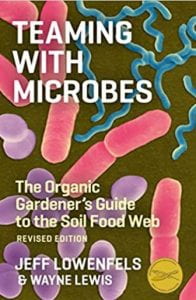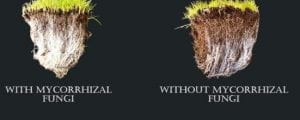10 things I didn’t know about soil
 I was given a couple of books for Christmas about soil. I read the fun-looking one a while ago but left the more serious one, Teaming with Microbes by Jeff Lowenfels and Wayne Lewis, and have only just got round to it. It turns out that you shouldn’t judge a book by its cover. I learnt masses from the second book so here are my top 10 amazing facts.
I was given a couple of books for Christmas about soil. I read the fun-looking one a while ago but left the more serious one, Teaming with Microbes by Jeff Lowenfels and Wayne Lewis, and have only just got round to it. It turns out that you shouldn’t judge a book by its cover. I learnt masses from the second book so here are my top 10 amazing facts.
- I have heard plants being called fast carbon pathways but haven’t ever really understood why. It turns out that as a result of photosynthesis, carbohydrates move back down a plant to the roots and then drip out of them. These carbohydrates and proteins that come out of the roots are known as exudates and are what attract the fungi and bacteria in the soil to them. Bacteria and fungi are eaten by protozoa and nematodes and their waste is absorbed by the plants as nutrients all of which happens in the rhizosphere which which is about 1mm around the root system of a plant. I like the analogy that is used in the book of bacteria and fungi being the small bags of fertilizer and the protozoa and nematodes act as fertilizer spreaders. All of this is controlled by the plant. Soil life provides the nutrients needed for plant life and plants initiate and fuel the cycle by producing exudates.

- Some plants prefer soil dominated by bacteria, others by fungi. I knew that there are organisms in the soil but I didn’t know that plants had preferences.
- Most vegetables, annuals and grasses prefer soil with more bacteria and their nitrogen in nitrate form.
- Most trees, shrubs and perennials prefer fungally dominated soils. In general, the longer a plant stays in the soil, the more it likes a fungally dominated soil. It make sense really. Annual plants are over in a year or less and that isn’t conducive to the hyphae on the fungi having enough time to grow and spread out. In fact, the bacterial numbers in the soil stay the same, it is the fungal numbers that increase.
- The compost that we add to a soil inoculates it with the micro organisms in it. The aged brown material we add feeds the fungus and the green stuff provides the sugars for the bacteria. Kelp and rock dust can be added to compost heaps and they provide food for fungal growth.
- Worm compost is rich in bacteria with very little fungal activity. That makes sense. The worms eat the scraps we put in and the microbes in their digestive system break them down. It is therefore best used on annual vegetables.
- Bacteria need more moisture than fungi and work quicker if the materials are ground up or shredded. This fits in with making the 18 day compost using the Berkeley method (which I still haven’t mastered yet!).
 The best way to support fungi is to spread a compost made with more brown material than green with the addition of rock dust if you have it. After this has been spread you could then mulch with wood chippings which will break down more slowly. I was thinking about raspberry canes when I read this.
The best way to support fungi is to spread a compost made with more brown material than green with the addition of rock dust if you have it. After this has been spread you could then mulch with wood chippings which will break down more slowly. I was thinking about raspberry canes when I read this.- There are two types of mycorrhizae: ectomycorrhizea and endomycorrhizae and plants prefer one rather than the other. Ectomycorrhizea grow around the roots of a plant and surround them, endomycorrhizae grow into the cells of the roots of a plant. Some mycorrhizae can act as ecto with one plant and endo with another. Fascinating and very flexible!
- It is worth using mycorrhizal fungi when transplanting all plants other than brassicas and chenopodia (spinach, beetroot etc). They do not utilise mycorrhizae.
There are a variety of actions that can develop bacteria and fungi in the soil – adding compost, mulching (or combine the two and mulch with compost!) and using actively aerated compost teas. I am still getting my head around these teas – they involve an air pump or being stirred for hours and so are not for the faint-hearted. What is easier to understand are the actions can damage the soil food web.
- Digging the soil will break up the rhizosphere, the hyphae on the fungi and destroy the structure of the soil created by the micro-organisms.
- Chemical fertilisers, insecticides, pesticides and fungicides affect the soil food web being toxic to some organisms, warding off others and changing the environment. When plants are fed chemically, the bacterial and fungal relationships with the plant are not formed, the microbial populations reduce as a result and the plant then needs constant chemical feeding.
If you are interested in the soil food web, Dr Elaine Ingham is the queen of this science and her How it Works videos explain the processes much more clearly than I can.
I am going to have to read the other book written by Lowenfel and Lewis – Teaming with Nutrients.